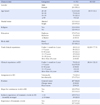Abstract
Purpose
This study was done to identify relationships among post-traumatic stress (PTS), job stress and turnover intention in emergency department (ED) nurses.
Methods
Participants were 250 ED nurses who had worked for one month or longer in the ED one of three university hospitals or seven general hospitals in Daegu City or Gyeong Buk Province in Korea. Structured questionnaires were used to measure PTS, job stress, and turnover intention of participants. Data were analyzed using descriptive statistics, one-way ANOVA, path analysis, and stepwise multiple regression with the SPSS program.
Results
There were significant relationships between PTS, job stress and turnover intention. PTS influenced turnover intention directly and was indirectly mediated by job stress. The experience of traumatic events influenced PTS, job stress, and turnover intention. Indirect experience of traumatic events in the ED was an important predictor, explaining 20.1% of PTS in high-risk post-traumatic participants.
Conclusion
PTS can be an important factor for job stress and turnover intention. The direct and indirect experience of traumatic events can influence PTS, job stress, and turnover intention in ED nurses. Based on these results, strategies for managing PTS and relating job stress are recommended to reduce turnover intention in ED nurses.
Figures and Tables
Table 2
Characteristics of Participants according to the Post-traumatic Stress, Job Stress and Turnover Intention (N=250)

References
1. American Psychiatric Association. Diagnostic and statistical manual of mental disorders. 1994. 4th ed. Washington, D.C: Authors;http://dx.doi.org/10.1176/appi.books.9780890423349.
2. Baek ML. Posttraumatic stress by work in firefighters. J Korean Soc Hazard Mitig. 2009. 9:59–65.
3. Carlier I, Voerman A, Gersons B. The influence of occupational debriefing on post-traumatic stress symptomatology in traumatized police officers. Br J Med Psychol. 2000. 73:87–98. http://dx.doi.org/10.1348/000711200160327.
4. Choi HK, Kim JH. Effects of traumatic events on posttraumatic stress disorder (PTSD), burnout, physical symptoms, and social and occupational functions in Korean fire fighters. Proceedings of the KAIS Fall Conference. 2010. 582–583.
5. Choi HJ, Baek JM, Seo SR. Secondary traumatic stress (STS) and related factors of emergency medical technicians. J Korean Soc Emerg Med Technol. 2009. 13:5–15.
6. Cohen SS, Mulvaney K. Field observations: Disaster medical assistance team response for hurricane Charley, Punta Gorda, Florida, August 2004. Disaster Manag Response. 2005. 3:22–27. http://dx.doi.org/10.1016/j.dmr.2004.10.003.
7. Dominguez-Gomez E, Rutledge DN. Prevalence of secondary traumatic stress emergency nurses. J Emerg Nurs. 2009. 35:199–204.
8. Eun HJ, Gwon TW, Lee SM, Kim TH, Choi MR, Cho SJ. A study on reliability and validity of the Korean version of impact of event scale-revised. J Korean Neuropsychiatr Assoc. 2005. 44:303–310.
9. Hooper C, Craig J, Janvrin DR, Wetsel MA, Reimels E. Compassion satisfaction, burnout, and compassion fatigue among emergency nurses compared with nurses in other selected inpatient specialties. J Emerg Nurs. 2010. 36:420–427.
10. Horowitz M, Wilner N, Alvarez W. Impact of Event Scale: A measure of subjective stress. Psychosom Med. 1979. 41:209–218.
11. Iverson RD. Employee intent to stay: An empirical test of a revision of the Price and Mueller model. 1992. Iowa: University of Iowa;Unpublished doctoral dissertation.
12. Kim BJ, Lee EN, Kang KH, Kim SS, Kim SE, Sung YH, et al. A study of job analysis of the emergency room nurse. Clin Nurs Res. 2006. 12:81–95.
13. Kim HJ. The relationships among traumatic events, compassion fatigue, burnout. 2011. Seoul, Korea: Konkuk University;Unpublished master's thesis.
14. Kim HJ, Choi HJ. Emergency nurses' professional quality of life: compassion satisfaction, burnout, and secondary traumatic stress. J Korean Acad Nurs Adm. 2012. 18:320–328.
15. Kim YJ. A study on post-traumatic stress in firefighters. 2011. Gimhae, Korea: Inje University;Unpublished master's thesis.
16. Kim YR. A study on the turnover intention of the oncology nurse. 2007. Gwangju, Korea: Chonnam National University;Unpublished master's thesis.
17. Kwon DW, Koh HJ. A study of job stress and turnover intention related to transfer of duty post of staff nurses in the general hospitals. J Korean Acad Nurs Adm. 2003. 9:141–154.
18. Kwon SC, Song JC, Lee SJ, Kim IN, Koh JW, Ryu HC, et al. Posttraumatic stress symptoms and related factors in firefighters of a fire station. Korean J Occup Environ Med. 2008. 20:193–204.
19. Laposa JM, Alden EL, Fullerton LM. Work stress and posttraumatic stress disorder in ED nurses/personnel. J Emerg Nurs. 2003. 29:23–28. http://dx.doi.org/10.1067/men.2003.7.
20. Lee HS. A comparative study on the PTSD of policeman and firefighters. Korean Rev Crisis Emerg Manage. 2012. 8:57–70.
21. Heinrichs M, Wagner D, Schoch W, Soravia LM, Hellhammer DH, Ehlert U. Predicting posttraumatic stress symptoms from pretraumatic risk factors: A 2-year prospective follow-up study in firefighters. Am J Psychiatry. 2005. 162:2276–2286.
22. McCann IL, Pearlman LA. Vicarious traumatization: A framework for understanding the psychological effects of working with victims. J Trauma Stress. 1990. 3:130–150. http://dx.doi.org/10.1007/BF00975140.
23. Oh JH, Lim NY. Analysis of factors influencing secondary traumatic stress, burnout, and physical symptoms in firefighters. J Korean Acad Fundam Nurs. 2006. 13:96–106.
24. Oh MO, Sung MH, Kim YW. Job stress, fatigue, job satisfaction and commitment to organization in emergency department nurses. J Korean Clin Nurs Res. 2011. 17:215–227.
25. Parker DF, Decotiis TA. Organizational determinants of job stress. Organ Behav Hum Perform. 1983. 32:160–177. http://dx.doi.org/10.1016/0030-5073(83)90145-9.
26. Patterson GT. Examining the effects of coping and social support on work and life stress among police officers. J Crim Justice. 2003. 31:215–226. http://dx.doi.org/10.1016/S0047-2352 (03)00003-5.
27. Song CJ. Mechanisms and treatment of posttraumatic stress disorder. Dongguk J Med. 2004. 11:102–112.
28. Sung MH, Cho SY. The relationship between job characteristics and organizational commitment, and turnover intention in emergency department nurses. J Korean Acad Fundam Nurs. 2010. 17:566–574.
29. Weiss DS, Marmar CR. Wilson JP, Keane TM, editors. The impact of event scalerevised. Assessing psychological trauma and PTSD: A practitioner's handbook. 1997. New York, NY: Guilford Press;399–411.
30. Yun CG, Lee HN. A study on the job stress of nurses in hospital. J Korean Soc Health Stat. 2003. 28:95–109.




 PDF
PDF ePub
ePub Citation
Citation Print
Print






 XML Download
XML Download